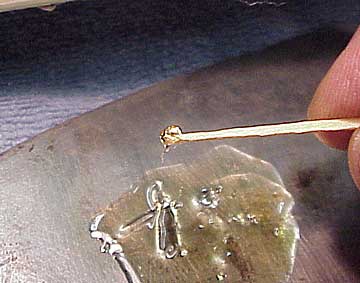Hot Epoxy Finish Fill
© Frank Ford, 1/1/99; Photos by FF, 1/1/99
I like to use clear epoxy to fill deep or broad dents, because the epoxy fill is very durable even if the fill is deep or broad. Also, it's not affected by the lacquer that I'll be using over the top to blend in with the surrounding finish.
If you look at my little plastic cup, you'll notice the epoxy is deep amber. The West System epoxy hardener tends to turn amber in the can once it's opened. It turns out that this dark amber color fits very well for a touchup on dark woods. According to the manufacturer, the discolored epoxy has the same working and longevity characteristics in spite of its color. I would definitely use only new, clear epoxy for a fill in a spruce top or other blond wood.
When I mix the epoxy, I invariably get a lot of bubbles, which can really mess up a finish fill. If I take a small portion of the mixed epoxy and make a puddle on my putty knife, I can heat it easily and quickly from underneath:

It may not be obvious in this picture, but I've heated the knife blade from one end, and allowed the heat to spread along the blade, resulting in puddle that's starting to set quickly at one end, and is still very runny at the other:

The heat causes an immediate decrease in the viscosity of the mixture, allowing the bubbles to rise, so I can easily pick up drops of clear epoxy with no bubbles at all:

As I poke around in the puddle, I can select a drop with exactly the viscosity I want:

I have to move fast, though, because the stuff is starting to set.
Placing a drop of honey-thick epoxy right into the dent, I have a fill that cools and becomes so thick that it won't run or sag, even on a vertical surface:

On top of that, it has no bubbles, and will set MUCH faster than if I had used cold epoxy.
From here, I'll scrape and sand the fill to just below the surface of the lacquer, and follow with lacquer touchup.
Using little blobs from my initial mixed batch, I can repeat this process quite a few times without having to mix up new epoxy.
Back to Index Page